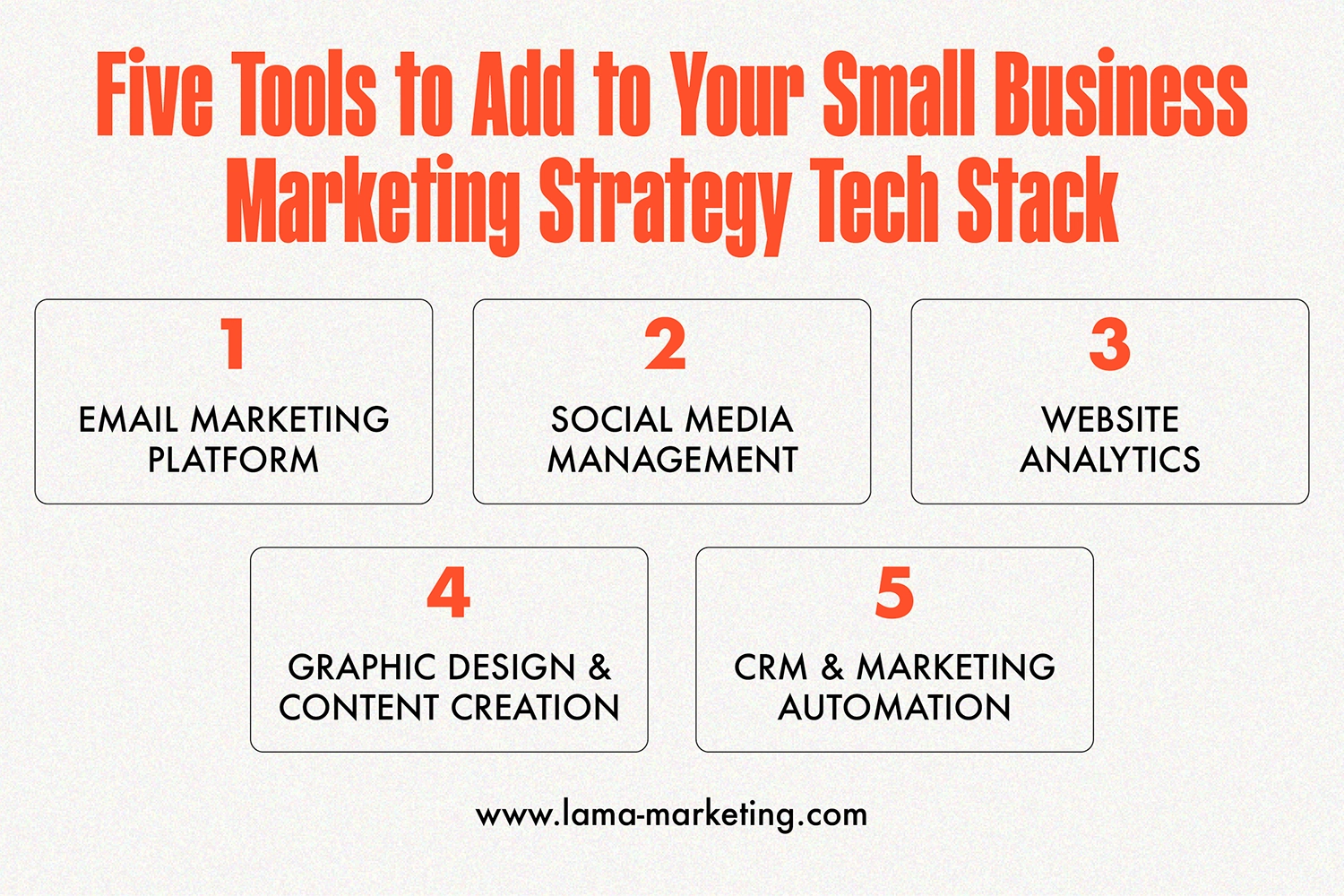You’ve probably heard the phrase “marketing tech stack” tossed around. And if it sounds a little intimidating, you’re not alone. But at its core, a marketing tech stack is simply the collection of digital tools and platforms you use to promote your business, connect with customers, and track results.
For small businesses, the right tools can help you compete with bigger brands, stay organized, and make smarter marketing decisions without a massive budget. But what are the right tools for your marketing needs? That’s an excellent question, and one that we’ll answer in this article. After all, our goal is to help you work smarter. Not harder.

Tool # 1: Email Marketing Platform
Let’s start by reassuring you of one important fact: email marketing is not dead. We can assure you that it is very much alive and more powerful than ever for small businesses.
With around 4.6 billion global email users in 2025 (and that number expected to reach 4.8 billion by 2027), email remains one of the most direct and reliable ways to reach your audience. Even more convincing? 59% of consumers say that marketing emails contribute to their purchase decisions, and over half report buying something from an email at least once a month.
For small businesses, email is affordable, measurable, and perfect for building long-term customer relationships.
So, what features should you look for?
- Drag-and-drop email builder
- List segmentation and tagging
- Automation and drip campaign tools
- Analytics and reporting
- Mobile-friendly templates
- Integrations with your website or CRM
If you’re just getting started, these beginner-friendly platforms offer free plans that make it easy to test the waters and grow your list.
- Mailchimp
- MailerLite
- Constant Contact
- Brevo (formerly Sendinblue)
- Moosend
These tools make it easy to get started, send professional-looking emails, and track how your audience responds, all without breaking the bank.
Tool # 2: Social Media Management
Chances are, you spend a good amount of time on social media. And here’s the thing. So do your customers. The average person clocks in at 2 hours and 24 minutes per day on platforms like Instagram, Facebook, TikTok, and LinkedIn. That’s a major opportunity for your business to stay visible, build relationships, and grow your brand.
But success on social media isn’t about showing up once in a while. It’s about consistent posting, timely responses, and staying active across the platforms your audience uses most. That’s where a good social media management tool comes in.
Here are the key features to look for:
- Multi-platform scheduling
- Content calendar and post previews
- Comment and message management
- Analytics and engagement tracking
- Team collaboration (if applicable)
And be sure to check out these beginner-friendly and affordable options:
- Simple scheduling and clean interface: Buffer offers a user-friendly experience and a free plan that’s great for basic post scheduling.
- Visual content planning for Instagram: Later makes it easy to drag, drop, and preview your grid before posting.
- Robust features for growing brands: Hootsuite includes multi-platform management and analytics, with a limited free option.
- All-in-one planning and analytics: Metricool is a budget-friendly tool that helps with both scheduling and performance tracking.
These tools help you keep your social presence organized, so you can focus more on engagement and less on scrambling to post last-minute content.

Tool #3: Website Analytics
If you have a website, you need a way to understand what’s actually happening on it and that’s what website analytics are all about. These tools help you track visitor behavior, where your traffic is coming from, which pages are performing best, and whether users are completing important actions like filling out a form or making a purchase.
For small businesses, this data is a goldmine. It can show you which marketing efforts are driving results, where people are dropping off, and what content is keeping them engaged.
Here’s what to focus on, especially if you are just getting started.
- Top traffic sources (organic search, social, direct, etc.)
- Most visited pages
- Bounce rate and average time on site
- Conversion goals (like form fills or purchases)
Getting started is easier than you think. Tools like Google Analytics 4 (GA4) are free and fairly quick to set up using a simple tag or Google Tag Manager. With just a little effort, you’ll have access to the kind of data that can truly shape your strategy.
Tool # 4: Graphic Design and Content Creation
Your emails, social media posts, and website won’t get far without strong visuals and engaging content. Eye-catching graphics and well-crafted messages are what grab attention and keep your audience interested. But let’s be honest. Not everyone has the time, talent, or energy to design scroll-stopping content on their own.
That’s where tools and freelancers come in. Platforms like Canva make it easy for non-designers to create polished visuals. And if you're too busy (or just not into DIY), hiring a freelancer can save you time while keeping your brand looking professional. Sites like Upwork, Fiverr, or even a local creative partner can help bring your vision to life.
If you're considering a design tool like Canva, here’s a quick look at what you get with a free plan versus a paid upgrade:
- Free: Drag-and-drop editor, templates, access to basic design elements
- Paid (Pro): Premium templates, brand kits, background remover, content scheduling, team collaboration
Whether you DIY or outsource, quality content is non-negotiable.
Tool # 5: CRM and Marketing Automation
Marketing takes time, and doing everything manually? That’s a fast track to burnout. That’s why a CRM (Customer Relationship Management) tool with built-in marketing automation is a super smart addition to any small business tech stack. These tools help you keep track of customer details, simplify and organize communication, and automate repetitive tasks like follow-up emails, form responses, and lead nurturing.
A good CRM can act as your marketing HQ, giving you a clear view of who your customers are, where they are in the buying process, and what messages they’ve interacted with.
Here’s what to look for.
- Contact and lead tracking
- Email sequences and workflows
- Web form and landing page integration
- Task reminders and deal tracking
- Reporting and performance dashboards
Check out these small business-friendly CRM options.
- HubSpot CRM: Free with solid automation and marketing tools
- Zoho CRM: Affordable and customizable
- MailerLite: Includes CRM-lite features in its email platform
These tools keep your marketing consistent without adding more to your plate.

Build a Smarter Marketing Strategy Tech Stack for Your Small Business
The right tools can help your small business market smarter, save time, and connect with customers more meaningfully. From email and social scheduling to analytics and automation, your tech stack doesn’t have to be overwhelming—it just has to work for you.
Need help figuring out where to start or what to add next? At LAMA, we help small businesses grow with expert support in digital marketing, SEO, website development, and more.
Reach out today. We’re here to help you build smarter.



.webp)










